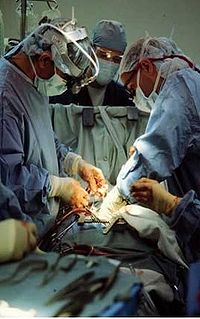
Photo from wikipedia
AIMS The study aimed to develop a nomogram model for predicting prolonged mechanical ventilation (PMV) in patients undergoing cardiovascular surgery. METHODS AND RESULTS In total, 693 patients undergoing cardiovascular surgery… Click to show full abstract
AIMS The study aimed to develop a nomogram model for predicting prolonged mechanical ventilation (PMV) in patients undergoing cardiovascular surgery. METHODS AND RESULTS In total, 693 patients undergoing cardiovascular surgery at an Affiliated Hospital of Nantong University between January 2018 and June 2020 were studied. Postoperative PMV was required in 147 patients (21.2%). Logistic regression analysis showed that delirium (Odds ratio [OR], 3.063; 95% confidence interval [CI], 1.991-4.713; P < 0.001), intraoperative blood transfusion (OR, 2.489; 95% CI, 1.565-3.960; P < 0.001), obesity (OR, 2.789; 95% CI, 1.543-5.040; P = 0.001), postoperative serum creatinine level (mmol/L; OR, 1.012; 95% CI, 1.007-1.017; P < 0.001), postoperative serum albumin level (g/L; OR, 0.937; 95% CI, 0.902-0.973; P = 0.001), and postoperative total bilirubin level (μmol/L; OR, 1.020; 95% CI, 1.005-1.034; P = 0.008) were independent risk factors for PMV. The area under the receiver operating characteristic curve for our nomogram was found to be 0.770 (95% CI, 0.727-0.813). The goodness-of-fit test indicated that the model fitted the data well (χ2 = 12.480, P = 0.131). After the model was internally validated, the calibration plot demonstrated good performance of the nomogram, as supported by the Harrell concordance index of 0.760. DCA demonstrated that the nomogram was clinically useful in identifying patients at risk for PMV. CONCLUSIONS We established a new nomogram model that may provide an individual prediction of PMV. This model may provide nurses, social workers, physicians, and administrators with an accurate and objective assessment tool to identify patients at high risk for PMV after cardiovascular surgery.
Journal Title: European journal of cardiovascular nursing
Year Published: 2022
Link to full text (if available)
Share on Social Media: Sign Up to like & get
recommendations!